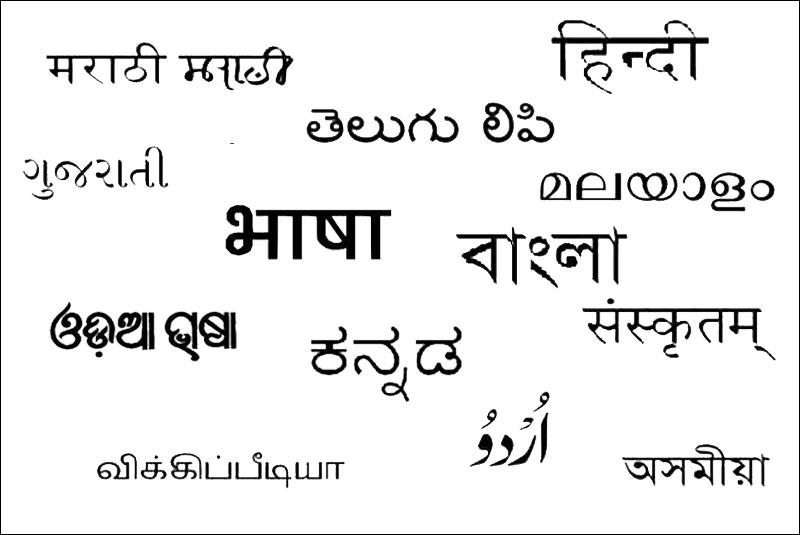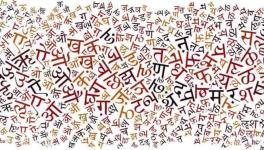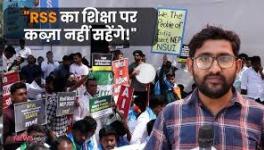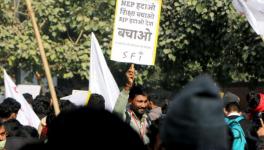How NEP 2020 Uses Language to Create a Rigid National Identity

When the Draft National Education Policy was made public in 2019, it generated responses that ranged from “too good to be true” to “conservative conspiracy”. It was obvious in particular from the reactions to the language aspect of this draft that this still is a potentially divisive issue, as likely to stir sentiment today as during the Constituent Assembly debates on language. Now that the final NEP 2020 is out, it has become clear that this policy is going to be weak on implementation, especially on the language front.
No discussion on education is complete without reference to language. The NEP recognises India’s linguistic diversity, accepts the importance of multilingualism and bilingual education and the need for capacity building in Indian languages. It recognises the erosion of local languages, including tribal languages, and expresses concern over the shrinking space for them. Yet, there is a need to read between the lines of this policy’s language-related recommendations.
A close reading shows an evident lack of understanding in the NEP of language itself and serious inadequacies in how it has engaged with the question of Indian languages. For instance, it glorifies Indian languages as “very scientifically structured” and claims they do not “have unphonetic, complicated spellings of words and numerous grammatical exceptions”. This smacks of ignorance of the nature of language. No language is “scientific” and phonetically “correct”. Making fun of the English spelling system may be an enjoyable pastime for some, but no language can claim consistent sound-symbol correspondence.
The drafters of the NEP seem aware that young children can learn new languages quickly if they are immersed in multilingual situations early on. It draws insight from cognitive psychology to recommend the use of home language/mother tongue as the medium of instruction. (The Prime Minister recently endorsed this view). Endorsement and adulation, however, does not excuse the policymakers’ lack of understanding. The terms “home language”, “mother tongue” and “local language” are used as if one can replace the other. All three are, in fact, seen as replacements of each other or equally viable options, leaving the reader wondering what they mean when used in different parts of the policy.
Home language, or what is spoken at a child’s home, morphs into “mother tongue” or “local language”, as the policy makes no effort to distinguish them. This confusion cannot be considered a result of ignorance. Rather, it suggests an inadequacy of understanding of these terms. Is home language always the mother tongue too? Will the local language always be the home language? What is the local language of a child who lives in Aligarh and is familiar with Hindi at home, hears Urdu in the locality and learns in English at school? What is the local language of a child whose family speaks Bhojpuri and lives in a Hindi-speaking part of Mumbai? More urgently, what about a North Indian living in Chennai or vice versa—which is the local and home language of either?
Language policymakers need to be reminded that multilingualism and linguistic heterogeneity—religious, ethnic, cultural and linguistic diversities—are the essential reasons for India’s survival as a nation. They require a better analytical lens to view linguistic practices, which bring meaning to communication. Language is a ubiquitous and polymorphous phenomenon, and in India, language boundaries are fluid, as captured by the term “multilinguality”. Multilinguality places the speaker at the heart of interactions.
For instance, many who speak Urdu, Hindi and English would describe all three as their language. The question of mother tongue will always remain problematic for such individuals and groups. Only the speakers, because they are at the heart of this interaction, can answer the question of what their “mother tongue” or “home language” is. Unfortunately, our Census enumerators do not offer people the choice of language. The questionnaires are designed and constructed in such a way that respondents have to pick one language, for example, Hindi or Urdu. You are neither allowed to say “both” nor have you the space to write Bhojpuri or Braj or Magahi, etc. For official purposes, your identity is “a language” but for me, as a speaker, it is not.
The NEP thus resembles the Downward Filtration objective of the Woods’ Despatch of 1854, which proposed “vernacular” language as the medium of instruction in Indian schools. The only departure the NEP makes is replacing English imperialism with Hindi imperialism—this is left unsaid, of course. In fact, the Census as state apparatus constantly creates and submerges identity, and this explains how the speakers of 49 varieties of Hindi in the 2001 Census and 56 in the 2011 Census, have all been subsumed into “Hindi-speakers”. This is despite the fact that many of them, such as those speaking Shekhawati or Dhundhari in Rajasthan, Haryanvi in Haryana, Chambeali in Uttarakhand, Khorthea/Khotta in Bihar, Laria in Chhattisgarh, etc. have problems speaking Hindi.
The NEP is sensitive to the multilingual ethos and conscious of linguistic capital and language as a source of power, for it refers to multilingualism over half a dozen times. It considers multilingualism a “boon and an opportunity for learning and expanding one’s horizons rather than a burden”. However, it does not situate the language policy framework in the context of India’s history and society. Nor does it provide a full accounting of the complexities of multilingualism, which include the mobility, mixing, political dynamics and historical embeddedness that are rapidly changing language profiles of individuals and communities, especially in larger cities. The uneven distribution of multilingualism and growing number of people who claim to have more than one first language also are ignored.
The NEP is conscious of the hegemonic position of English in India, and notes that the trend in schools and society is increasingly towards English as a medium of instruction and conversation. But even here, a socio-historical anchor is absent in the policy. For instance, to check the surge in indispensability of English, in all naïvety, it suggests that the elite and educated section make the “major effort” to use Indian languages and give them the “space and respect that they deserve”. This is nothing but a lack of understanding of how aspirations and expectations for better communication gives both power and sacrament to English, especially in professional institutions where there is a higher density of cultural and linguistic heterogeneity. English is now placed at the intersection of society, politics, economic and even religion—if only one could avail of opportunities created by the “Goddess English”!
In the same vein of heterogeneity, there are broadly two kinds of higher education institutions in India—those of national importance or centrally-funded, which have wider linguistic heterogeneity in enrolment and pedagogy. The second kind is the regional universities, with lesser linguistic heterogeneity. The question is, does the NEP address this issue and explain how its proposals will be implemented? For instance, in how many Indian languages can we make study material available in the regional institutions? Where will the financial and human resources for this come from? Even at the level of schooling, there is a lack of clarity. Unlike the fifties, today India has large inter-state and inter-regional migrations. Can India really provide education in the “mother tongue” to every migrant’s child? And what happens as families move from one linguistic province to another? Should we even pursue such a policy is one more question for policymakers.
The scarcity of translated school textbooks in India is legion. The translation projects run from the Delhi College, the 19th century’s Scientific Societies of Aligarh and Bihar and the late colonial Osmania University’s attempts, after all, came to nought. All said and done, the unsaid message of the NEP has not been lost on those who are not native Hindi-speakers: its goal, albeit unspoken, is to banish English and impose Hindi. As expected, this has not gone down well.
The assumption embedded in the policy, that English and English-aware elites are responsible for the marginalisation of other Indian languages, is also quite naïve. It shows the policy’s ignorance of the history of the Indian sensibility of language. The monolithic view of a “common culture” with a “national character” and the notion of different languages (or “a language”) bounded by specific linguistic features is not at all in keeping with the linguistically heterogeneous environment of the pre-colonial world. The edifice of linguistic plurality in the Indian subcontinent, according to the noted linguist LM Khubchandani, is “traditionally based upon the complementary use of more than one language and more than one writing system for the same language in one space”. In fact, languages were regarded as features of the landscape with instrumental value as opposed to comprising an aspect of individual or community identity.
A personal account of one of the present authors, M. Sajjad, illustrates this point: his home language is an unnamed dialect (possibly a mix of Urdu/Hindi, Awadhi in a Vajjika sub-region). He studied at the Government Urdu Primary School in his village in North Bihar. He was given primary instruction by parents, grandparents and home tutors in the English and Hindi languages, and in grammar, translation and literature. At the Hindi-medium government high school of the village, some teachers and the headmaster took special care to develop English language skills and knowledge of literature. As he moved to a postgraduate college in the district town, the medium of instruction was almost fully English. Quality textbooks were generally written in English rather than Hindi. Finally, at a centrally-funded university (Aligarh Muslim University), he found that a number of his classmates had studied almost entirely in the Hindi/Urdu medium—even if they joined English-medium AMU in class XI or XII—and they found it very difficult to deal with English language even as they progressed to post-graduation.
This account is no exception but a typical experience of a multilingual Indian who “easily” deployed various languages in a linguistically heterogeneous region, depending on social contexts and specific needs, without any invisible cultural power or value assigned to one language over the other. Such a fluidity characterised language and society in pre-colonial India, in contrast to the colonial propensity for linguistic hierarchy.
In the pre-colonial and even early colonial eras, education was confined to a select few, and not really viewed as a state responsibility until the mid-19th century. The few exceptions are the institutions that existed in Nalanda, Takshila, Madarsa Ghaziuddin, etc. In today’s era, mass education is obtained and provided by the state, despite growing privatisation. So how do we manage linguistic plurality in the education system we have? How much of economic shared-ness is it possible to address? These are crucial questions missing from the NEP and such omissions complicate the question of whether it can be implemented at all.
Fact is, the NEP talks about language disadvantages, medium of instruction, and so on, but does not refer to multilingual education or MLE. As sociolinguists, our position is that language is multilinguality and multilinguality is constitutive of being human. What we have in the policy, instead, is the continued preoccupation with the contested colonial legacy of treating language as “a language”. The “invention” of languages by colonial ethnographers, through the process of classification and naming (we find this in Grierson’s Linguistic Survey of India) fostered an ideology of languages as separate and enumerable categories. “Bengali”, “Assamese”, etc were constructed as new objects based on the idea that languages are discrete entities—bound, impermeable, autonomous and countable, and often associated with a nation state. Whereas pre-colonial India did not predicate the idea of belonging to a place with the language one speaks. In other words, Indian identities were not formed on the basis of language, religion or race—a lesson those who framed the NEP seem to have missed.
If NEP had engaged with India’s linguistic history or the Indian language sensibility, its desire to preserve and promote all Indian languages, including tribal languages, would not have appeared like a posture. It looks at the past as a seamless tract and engages with the present superfluously. Therefore, it never makes a single suggestion that can really address the marginalisation of Indian languages, which it keeps referring to. In the final analysis, the drafters have simply let the policy document go, without recommending a much-needed national language policy, without which the question of marginalised Indian languages and the Indian sensibility towards language and values cannot be addressed.
Syed Imtiaz Hasnain teaches sociolinguistics, and Mohammad Sajjad teaches modern and contemporary Indian history, at Aligarh Muslim University. The views are personal.
Get the latest reports & analysis with people's perspective on Protests, movements & deep analytical videos, discussions of the current affairs in your Telegram app. Subscribe to NewsClick's Telegram channel & get Real-Time updates on stories, as they get published on our website.
























